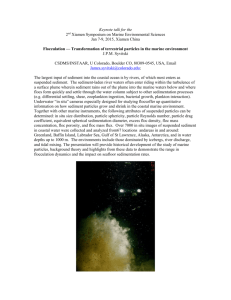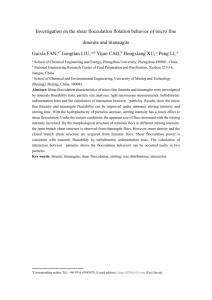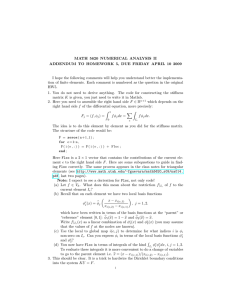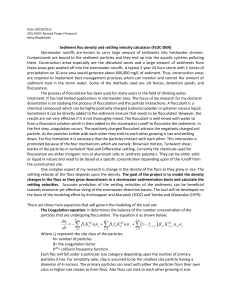The paradigm of coagulation processes of polystyrene latex particles
advertisement
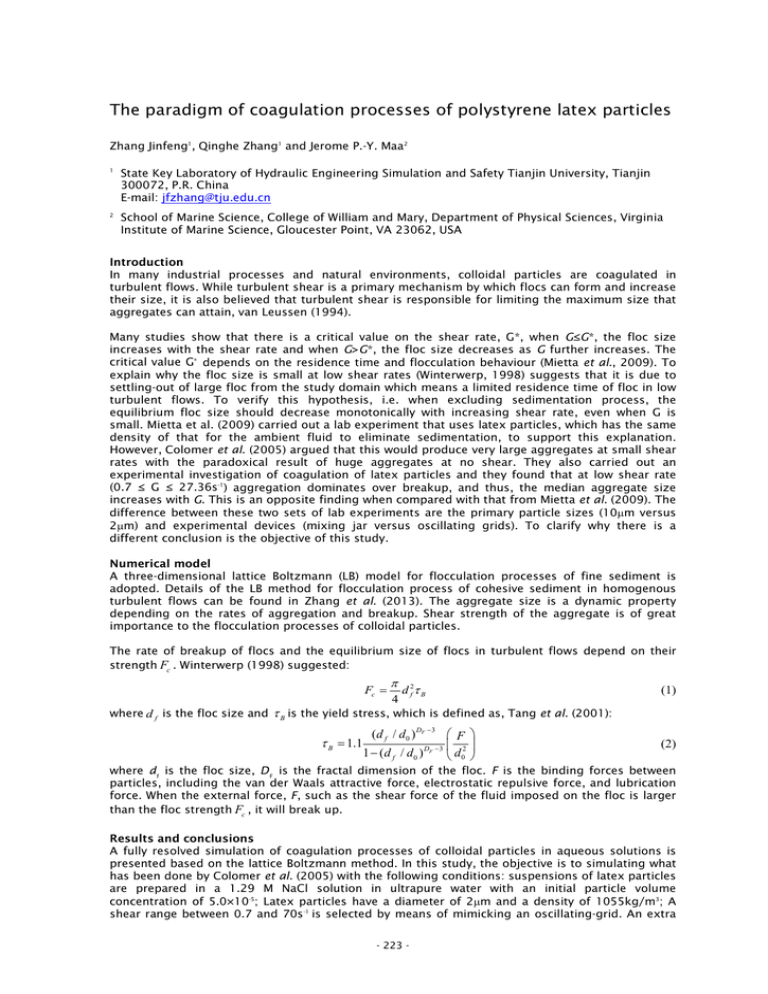
The paradigm of coagulation processes of polystyrene latex particles Zhang Jinfeng1, Qinghe Zhang1 and Jerome P.-Y. Maa2 1 State Key Laboratory of Hydraulic Engineering Simulation and Safety Tianjin University, Tianjin 300072, P.R. China E-mail: jfzhang@tju.edu.cn 2 School of Marine Science, College of William and Mary, Department of Physical Sciences, Virginia Institute of Marine Science, Gloucester Point, VA 23062, USA Introduction In many industrial processes and natural environments, colloidal particles are coagulated in turbulent flows. While turbulent shear is a primary mechanism by which flocs can form and increase their size, it is also believed that turbulent shear is responsible for limiting the maximum size that aggregates can attain, van Leussen (1994). Many studies show that there is a critical value on the shear rate, G*, when G≤G*, the floc size increases with the shear rate and when G>G*, the floc size decreases as G further increases. The critical value G∗ depends on the residence time and flocculation behaviour (Mietta et al., 2009). To explain why the floc size is small at low shear rates (Winterwerp, 1998) suggests that it is due to settling-out of large floc from the study domain which means a limited residence time of floc in low turbulent flows. To verify this hypothesis, i.e. when excluding sedimentation process, the equilibrium floc size should decrease monotonically with increasing shear rate, even when G is small. Mietta et al. (2009) carried out a lab experiment that uses latex particles, which has the same density of that for the ambient fluid to eliminate sedimentation, to support this explanation. However, Colomer et al. (2005) argued that this would produce very large aggregates at small shear rates with the paradoxical result of huge aggregates at no shear. They also carried out an experimental investigation of coagulation of latex particles and they found that at low shear rate (0.7 ≤ G ≤ 27.36s-1) aggregation dominates over breakup, and thus, the median aggregate size increases with G. This is an opposite finding when compared with that from Mietta et al. (2009). The difference between these two sets of lab experiments are the primary particle sizes (10µm versus 2µm) and experimental devices (mixing jar versus oscillating grids). To clarify why there is a different conclusion is the objective of this study. Numerical model A three-dimensional lattice Boltzmann (LB) model for flocculation processes of fine sediment is adopted. Details of the LB method for flocculation process of cohesive sediment in homogenous turbulent flows can be found in Zhang et al. (2013). The aggregate size is a dynamic property depending on the rates of aggregation and breakup. Shear strength of the aggregate is of great importance to the flocculation processes of colloidal particles. The rate of breakup of flocs and the equilibrium size of flocs in turbulent flows depend on their strength Fc . Winterwerp (1998) suggested: Fc = π 4 d 2f τ B (1) where d f is the floc size and τ B is the yield stress, which is defined as, Tang et al. (2001): τ B = 1.1 (d f / d 0 ) DF −3 F 1 − (d f / d 0 ) DF −3 d 02 (2) where d f is the floc size, D F is the fractal dimension of the floc. F is the binding forces between particles, including the van der Waals attractive force, electrostatic repulsive force, and lubrication force. When the external force, F, such as the shear force of the fluid imposed on the floc is larger than the floc strength Fc , it will break up. Results and conclusions A fully resolved simulation of coagulation processes of colloidal particles in aqueous solutions is presented based on the lattice Boltzmann method. In this study, the objective is to simulating what has been done by Colomer et al. (2005) with the following conditions: suspensions of latex particles are prepared in a 1.29 M NaCl solution in ultrapure water with an initial particle volume concentration of 5.0×10-5; Latex particles have a diameter of 2µm and a density of 1055kg/m3; A shear range between 0.7 and 70s-1 is selected by means of mimicking an oscillating-grid. An extra - 223 - size of latex particles (i.e. 10µm) will be added to check if the primary particle size is an affecting factor. The sedimentation mechanism is irrelevant because the density of the solution is the same as that of the particles. This implies an unlimited residence time during the coagulation processes. The interactions between solid particles and turbulence, solid particles and solid particles are considered to directly simulate the collision and cohesion processes of latex particles in the turbulent flows. The development of floc size distribution is simulated at the steady-state of coagulation and breakup processes. An additional simulation by changing the ambient fluid density will be investigated to check the effect of the residence time on the flocculation process. References Colomer J., F. Peters and C. Marras. 2005. Experimental analysis of coagulation of particles under low-shear flow. Water Res. 39(13):2994–3000. Mietta F., C. Chassagne and J.C. Winterwerp. 2009. Shear-induced flocculation of a suspension of kaolinite as function of pH and salt concentration. Journal of Colloid and Interface Science 336(1):134–141. Serra T., J. Colomer and B.E. Logan. 2008. Efficiency of different shear devices on flocculation. Water Res. 42:1113–1121. Tang S., Y. Ma and C. Shiu. 2001. Modelling the mechanical strength of fractal aggregates. Colloids and surfaces. A: Physicochemical and engineering aspects 180(1):7–l6. Van Leussen W. 1994. Estuarine macroflocs and their role in fine-grained sediment transport. Ph.D. Thesis, University of Utrecht, the Netherlands. Winterwerp J.C. 1998. A simple model for turbulence induced flocculation of cohesive sediment. Journal of Hydraulic Research, IAHR 36(3):309–326. Zhang J.F., Q.H. Zhang, J.P.Y. Maa and G.Q. Qiao. 2013. Lattice Boltzmann simulation of turbulenceinduced flocculation of cohesive sediment. Ocean Dynamics 63(9-10):1123-1135. - 224 -

